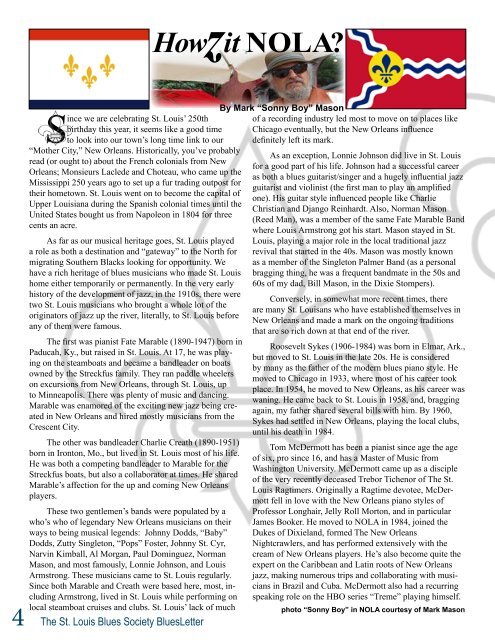BluesLetter_May14_web
BluesLetter_May14_web
BluesLetter_May14_web
You also want an ePaper? Increase the reach of your titles
YUMPU automatically turns print PDFs into web optimized ePapers that Google loves.
Howzit NOLA<br />
Since we are celebrating St. Louis’ 250th<br />
birthday this year, it seems like a good time<br />
to look into our town’s long time link to our<br />
“Mother City,” New Orleans. Historically, you’ve probably<br />
read (or ought to) about the French colonials from New<br />
Orleans; Monsieurs Laclede and Choteau, who came up the<br />
Mississippi 250 years ago to set up a fur trading outpost for<br />
their hometown. St. Louis went on to become the capital of<br />
Upper Louisiana during the Spanish colonial times until the<br />
United States bought us from Napoleon in 1804 for three<br />
cents an acre.<br />
As far as our musical heritage goes, St. Louis played<br />
a role as both a destination and “gateway” to the North for<br />
migrating Southern Blacks looking for opportunity. We<br />
have a rich heritage of blues musicians who made St. Louis<br />
home either temporarily or permanently. In the very early<br />
history of the development of jazz, in the 1910s, there were<br />
two St. Louis musicians who brought a whole lot of the<br />
originators of jazz up the river, literally, to St. Louis before<br />
any of them were famous.<br />
The first was pianist Fate Marable (1890-1947) born in<br />
Paducah, Ky., but raised in St. Louis. At 17, he was playing<br />
on the steamboats and became a bandleader on boats<br />
owned by the Streckfus family. They ran paddle wheelers<br />
on excursions from New Orleans, through St. Louis, up<br />
to Minneapolis. There was plenty of music and dancing.<br />
Marable was enamored of the exciting new jazz being created<br />
in New Orleans and hired mostly musicians from the<br />
Crescent City.<br />
The other was bandleader Charlie Creath (1890-1951)<br />
born in Ironton, Mo., but lived in St. Louis most of his life.<br />
He was both a competing bandleader to Marable for the<br />
Streckfus boats, but also a collaborator at times. He shared<br />
Marable’s affection for the up and coming New Orleans<br />
players.<br />
These two gentlemen’s bands were populated by a<br />
who’s who of legendary New Orleans musicians on their<br />
ways to being musical legends: Johnny Dodds, “Baby”<br />
Dodds, Zutty Singleton, “Pops” Foster, Johnny St. Cyr,<br />
Narvin Kimball, Al Morgan, Paul Dominguez, Norman<br />
Mason, and most famously, Lonnie Johnson, and Louis<br />
Armstrong. These musicians came to St. Louis regularly.<br />
Since both Marable and Creath were based here, most, including<br />
Armstrong, lived in St. Louis while performing on<br />
local steamboat cruises and clubs. St. Louis’ lack of much<br />
4 The St. Louis Blues Society <strong>BluesLetter</strong><br />
By Mark “Sonny Boy” Mason<br />
of a recording industry led most to move on to places like<br />
Chicago eventually, but the New Orleans influence<br />
definitely left its mark.<br />
As an exception, Lonnie Johnson did live in St. Louis<br />
for a good part of his life. Johnson had a successful career<br />
as both a blues guitarist/singer and a hugely influential jazz<br />
guitarist and violinist (the first man to play an amplified<br />
one). His guitar style influenced people like Charlie<br />
Christian and Django Reinhardt. Also, Norman Mason<br />
(Reed Man), was a member of the same Fate Marable Band<br />
where Louis Armstrong got his start. Mason stayed in St.<br />
Louis, playing a major role in the local traditional jazz<br />
revival that started in the 40s. Mason was mostly known<br />
as a member of the Singleton Palmer Band (as a personal<br />
bragging thing, he was a frequent bandmate in the 50s and<br />
60s of my dad, Bill Mason, in the Dixie Stompers).<br />
Conversely, in somewhat more recent times, there<br />
are many St. Louisans who have established themselves in<br />
New Orleans and made a mark on the ongoing traditions<br />
that are so rich down at that end of the river.<br />
Roosevelt Sykes (1906-1984) was born in Elmar, Ark.,<br />
but moved to St. Louis in the late 20s. He is considered<br />
by many as the father of the modern blues piano style. He<br />
moved to Chicago in 1933, where most of his career took<br />
place. In 1954, he moved to New Orleans, as his career was<br />
waning. He came back to St. Louis in 1958, and, bragging<br />
again, my father shared several bills with him. By 1960,<br />
Sykes had settled in New Orleans, playing the local clubs,<br />
until his death in 1984.<br />
Tom McDermott has been a pianist since age the age<br />
of six, pro since 16, and has a Master of Music from<br />
Washington University. McDermott came up as a disciple<br />
of the very recently deceased Trebor Tichenor of The St.<br />
Louis Ragtimers. Originally a Ragtime devotee, McDermott<br />
fell in love with the New Orleans piano styles of<br />
Professor Longhair, Jelly Roll Morton, and in particular<br />
James Booker. He moved to NOLA in 1984, joined the<br />
Dukes of Dixieland, formed The New Orleans<br />
Nightcrawlers, and has performed extensively with the<br />
cream of New Orleans players. He’s also become quite the<br />
expert on the Caribbean and Latin roots of New Orleans<br />
jazz, making numerous trips and collaborating with musicians<br />
in Brazil and Cuba. McDermott also had a recurring<br />
speaking role on the HBO series “Treme” playing himself.<br />
photo “Sonny Boy” in NOLA courtesy of Mark Mason


